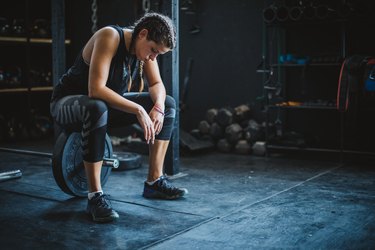
You just crushed a workout at the gym, and you know you're going to be sore tomorrow. We've all been there. But are sore muscles a good sign? Do sore muscles burn fat?
Tip
Sore muscles burn calories, though the number of calories you burn depends on your body composition and your basal metabolic rate (BMR). Those calories may or may not come from fat.
Video of the Day
Your Body Composition Matters
According to an August 2018 study in Clinical Nutrition Experimental, body composition plays a major role in the amount of calories you burn every day. Every day, 60 to 75 percent of energy expenditure occurs at rest, while 15 to 30 percent comes from physical activity and 10 percent is used for converting food into energy.
Video of the Day
How many calories you burn every day is determined mainly by the amount of lean muscle tissue in the body. Naturally, women have lower resting energy expenditure than men, and older people have lower energy expenditure than younger subjects.
The researchers also found that "physical activity can have a major impact on total 24-hour energy expenditure and energy balance." It may speed up the resting metabolic rate (RMR) and affect the thermal effect of food, as RMR runs higher in individuals who exercise compared to sedentary people of the same weight.
The more muscle you have, the more calories you burn. However, a February 2016 study in Current Biology reveals the old adage that more exercise is better isn't true. Researchers determined daily calorie burn and health plateaus happen, and beyond that, people get minimal incremental gains.
Read more: Fat Burning Vs. Carbohydrate Burning
Do Sore Muscles Burn Fat?
Sore muscles are the result of your workout damaging the muscle tissue and fiber. Your body burns calories during the workout, and will continue to do so after the rest and repair stage. However, you won't necessarily burn more calories faster, because your body will return to its RMR fairly quickly after exercise.
The muscle recovery period that makes your muscles bigger and stronger occurs for up to 48 hours after a weightlifting workout, but the body requires sufficient protein stores to facilitate the process.
Burning calories is not the same as burning fat. Calories refer to energy, and are found in all macronutrients. According to Christopher Wharton, PhD, a certified personal trainer and professor at Arizona State University, 10 pounds of muscle would burn 50 calories in a day spent at rest, while 10 pounds of fat would burn 20 calories. To be sure you're burning fat, take periodic measurements. If you're losing inches but not seeing the scale move, it's likely lean muscle is replacing fat.
Read more: 5 Workouts for Strength Training at Home
Dealing With Sore Muscles
Muscle soreness may not happen immediately following your workout. Instead, you may suffer from delayed-onset muscle soreness, also known as DOMS, within six to eight hours after activity, reaching its peak within 24 to 48 hours after training.
If your question is, "If my muscles are sore, should I rest?" the answer is yes! Resting the muscles when they're sore is essential to giving them time to heal and repair. This is why many people opt to work their upper body one day and their lower body the next. Rest is necessary for optimal health, but recovery workouts can help you stay active.
- American Council on Exercise: "Resting Metabolic Rate: Best Ways to Measure It—And Raise It, Too"
- ScienceDirect: Clinical Nutrition Experimental: "Body Weight Control and Energy Expenditure"
- Mayo Clinic: "Metabolism and Weight Loss: How You Burn Calories"
- Current Biology: "Exercise: Is More Always Better?"
- MedlinePlus: "Can You Boost Your Metabolism?"
- Arizona State University iSearch: "Christopher Wharton"
- National Institute on Aging: Exercise